In the late 1950s, in response to increased opposition from foreign companies, General-Motors, Chrysler, and Ford each recognised a need for a domestically produced compact car, to meet growing market demand. To the rest of the world, their offerings, the Chrysler Valiant, Chevrolet Corvair, and Ford Falcon might be considered more mid-sized than compact, but in a market whose local products were expanding in all directions to huge proportions, these new vehicles were, by comparison, exactly as their market segment suggested.
Fords new Falcon first hit the market in late 1959, and sales were strong. But while this new entry-level model lacked frills, it also lacked thrills, and until the 260ci V8 was offered for the first time mid-way through the 1963 model range, its performance was more sedate, than sporting. But the addition of the spritely little V8, originally designed for the Falcons bigger brother, the Fairlane, was introduced along with a new sporty Falcon, the Futura Sprint. The new small block V8 transformed the Falcon, and Ford were keen to target the youth market, using the international stage as their platform, when in 1963 they entered a fleet of Holman-Moody prepared Falcon Sprint hardtops in the most unlikely of events for an American vehicle, the Monte Carlo Rally.
Even though by US standards the Falcon was considered a compact car, by European standards, it very much wasn’t, and this decision had all the makings for exposing the Fords as being exactly what many considered them to be; large American cars better suited to straight stretches of freeway. But H-M knew how to build strong race cars, and they knew how to get the small block V8 to perform.
Swedish championship winning rally driver Bo Ljungfeldt was contracted to drive one of the three Falcons, and proved an absolute sensation. On anything remotely resembling a straight stretch of road, Ljungfeldt extracted everything from his galloping V8 Falcon. His experience in ice racing also proved crucial, as Europe was in the midst of its coldest winter for many years. He stunned everyone when he set fastest time on all six special performance Alpine pass stages. But ultimately, the Falcons finished the rally well down the order, when they picked up road penalties through traffic delays which put them on the back-foot, and their bristling performances couldn’t make up the short-fall. But Ford had entered the Monte because it was one of the few events at the time to gain international media exposure, and their conquests had brought the Falcon wide-spread positive reviews.
The 1964 model year brought about the bold second-generation Falcon, with spear-side body styling, and which included an attractive new Sprint. Part-way through the 1964 model year, the new 289ci V8 was also offered as the top performing engine package.
Again, Ford entered the Monte Carlo Rally, this time with eight cars. The FIA offered an impossible but tempting homologation minimum racing weight of just 960kg, and in their attempts to get the cars near this weight, Holman-Moody outfitted the Falcons with fibreglass replacement panels for the bonnet, boot lid, front fenders, and doors.
Again, Ljungfeldt was star of the show, once more winning all six Alpine stages, although works BMC Mini Cooper driver Paddy Hopkirk equalled him on one stage, and was ultimately awarded the overall win based on a handicapping system which favoured his smaller engine size. Ljungfeldt was second.
With Ford releasing the sporty new Mustang in April 1964, their focus towards the compact performance market shifted away from the Falcon, which continued on quietly within their line-up until eventually being dropped in 1970, amidst slumping sales. The 1964 Monte Carlo Rally might well have been the final chapter in the Falcons otherwise very brief motor racing history, and the handsome Sprint models competition life might well have faded quietly into the history books, had it not been for a distinctly different discipline to that of rallying; touring car racing.
Through 1961 to 1965, the British Saloon Car Championship was contested to FIA Group 2 regulations. Internationally, Group 2 was a popular formula, and was also used in the European Touring Car Championship until 1967, Dutch Touring Car Championship from 1964 to 1967, German Touring Car Championship from 1963 to 1966, and in other domestic touring car championships throughout Europe. Group 2 was used in New Zealand during the 1966 and 1967 seasons, and were the regulations the Sports Car Club of America initially structured the Trans-Am championship around in 1966.




 Reply With Quote
Reply With Quote











